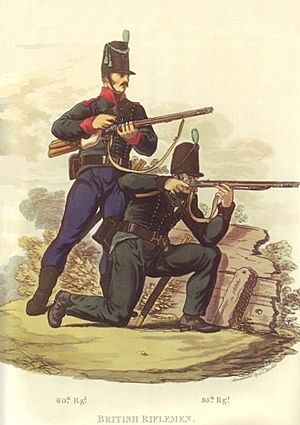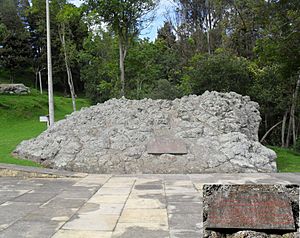British Legions facts for kids
Quick facts for kids British Legions |
|
|---|---|

Rifle regiments similar to those who would have fought under Bolivar
|
|
| Active | 1817–1824 |
| Country | |
| Allegiance | |
| Type | Infantry Cavalry Artillery |
| Size | ~6,500 |
| Motto(s) | "Morir o vencer (Die or Conquer)" |
| March | "Ye Gentlemen of England" |
| Engagements | Spanish American wars of independence |
| Commanders | |
| Supreme commander | Simón Bolívar |
| Notable commanders | James Rooke Arthur Sandes |
| Insignia | |
| The Union Flag carried throughout the campaigns. |  |
| Flag of the Irish Legion carried by General Devereux |  |
The British Legion (Spanish: Legión británica) or British Legions were groups of volunteer soldiers from other countries. They fought alongside Simón Bolívar against Spain to help countries like Colombia, Venezuela, Ecuador, and Peru gain their independence. These battles were part of the Spanish American wars of independence.
Venezuelans often called them the Albion Legion. More than seven thousand volunteers joined, mostly veterans from the Napoleonic Wars in Great Britain and Ireland. Some German veterans and local recruits also joined. These volunteers were driven by a mix of strong beliefs in freedom and the need for work.
The British Legions achieved great victories. They helped secure independence at the Boyacá (1819), Carabobo (1821), Pichincha (1822), and Battle of Ayacucho (1824). These wins freed Colombia, Venezuela, Ecuador, and Peru from Spanish rule.
Contents
Why British Soldiers Joined the Fight
After the Napoleonic Wars ended, the British Empire no longer needed a huge army. In 1817, a newspaper reported that about 500,000 former soldiers were without jobs. Many of these men had spent their lives fighting. They had no other skills or work experience. This often left them in poverty.
The wars for independence in South America offered a new chance. Many ex-soldiers could continue their military careers. This helped them escape poverty at home. Some Britons also worried that Spain might become a strong world power again. This could threaten Britain.
Reasons for Volunteering
The volunteers had different reasons for joining the British Legions. Many were inspired by Simón Bolívar's ideas. He promised freedom and rights to people under Spanish rule. This message was very appealing.
The British government quietly supported the recruitment of these volunteers. Even though they officially stopped supporting the rebels in 1814, they allowed it. Many recruits were also unemployed. They saw South America as a place to earn a living. They were paid soldiers, often called mercenaries.
How the Legions Were Formed
Starting in May 1817, British volunteers were mainly recruited in London. Simón Bolívar's agent, Luis Lopez Mendez, handled this. The Duke of Wellington likely approved these efforts.
Recruits were promised good pay, similar to the British army. They were also offered a promotion to a higher rank than they held before. Pay would start when they arrived in Venezuela. Thousands volunteered when they heard the call in London.
The first five groups were quickly formed:
| Early Units | Number of Soldiers |
|---|---|
| 1st Venezuelan Hussars: Colonel Gustavus Hippisley | 30 officers and 160 non-commissioned officers (NCOs) |
| 2nd Venezuelan Hussars (Red Hussars): Colonel Henry Wilson | 20 officers and 100 NCOs |
| 1st Venezuelan Lancers: Colonel Robert Skeene | 20 officers and 200 NCOs |
| 1st Venezuelan Rifles: Colonel Donald Campbell | 37 officers and 200 NCOs |
| Brigade of Artillery: Colonel Joseph Gilmour | 10 officers and 80 NCOs 5 small cannons, 1 howitzer |
Key Campaigns and Battles
The soldiers used Margarita Island as their main base. Conditions there were tough, and some died from disease. To replace lost soldiers, they recruited 100 local people.
Many expeditions brought soldiers to South America. Here is a summary of the numbers:
| Expedition Leader | Number of Soldiers |
|---|---|
| Colonel Hippisley | 720 |
| Colonel James Towers English | 1,200 |
| Colonel Elson | 572 |
| General John D’Evereux | 1,729 |
| General Gregor MacGregor | 600 |
| Colonel Meceroni | 300 |
| Colonel James Rooke | 200 |
| Others | 387 |
| Total | 5,508 |
Fighting in Colombia and Venezuela
The British Legions fought in the Venezuelan Llanos campaign in 1818. They took part in battles like El Sombrero and Calabozo. These early British recruits impressed Bolívar. He wanted more British volunteers.
In March 1819, Bolívar combined most foreign volunteers. He formed a brigade of 250 men called the British Legions. James Rooke became their commander. George Elsom went back to London to recruit more soldiers. Among his new recruits were 110 Hanoverians. These were German soldiers who had fought at Waterloo.
In June 1819, Elsom arrived with the first wave of British troops. There were about 2,200 men, fully equipped and uniformed. This group became known as the 'Second British Legion'. It included the 1st British Legion, the 2nd British Legion, and the Irish Legion.
The Legion adopted the motto Morir o vencer (Die or Conquer). They also had an anthem, played by their band. Their uniforms looked like those of the British army. In Ireland, a similar recruitment effort took place. John D’Evereux enlisted 1,700 men for the Irish Legion.
The Rifle Battalion joined Bolívar's army. Bolívar then reorganized his forces. The Rifles were strengthened by 350 more British troops. They were formed into two battalions. Colonel Arthur Sandes commanded the first, and Major John Mackintosh the second. Mackintosh later became a special assistant to Bolívar.
The British Legions joined Bolívar's army in late 1818. They saw little action until March 19, 1819. This was a small fight in the woods of Gamarra. Soon, they became a very important part of Bolívar's army. They had to endure a difficult and secret crossing of the Andes mountains. This journey from May to June caused great suffering for the Patriot army, including the British.
Crucial Battles
The Legions played a vital role at the Battle of Vargas Swamp on July 25. Bolívar's army was in trouble. Their left side was pushed back and fell into disorder. Rooke then led the 2nd Rifles against the Spanish. A fierce bayonet charge won back the positions for the Patriots. Rooke was badly wounded and died later. Sandes was also wounded twice. Despite heavy losses, the British troops fought bravely.
At the Battle of Boyacá on August 7, 1819, Sandes' Rifles Battalion led a bayonet charge. They attacked the royalist artillery. This attack changed the course of the battle. Bolívar praised them, saying they "deserve these laurels." They were given the ‘Order of the Liberator’. This was a rare honor for an entire unit during the war.
At the victory of Carabobo, Colonel Thomas Ilderton Ferrier led the Legion troops. They fought as part of the 1st Division. They defended important hills even though they were greatly outnumbered. Their heroic stand was the turning point of the battle. They suffered 119 casualties, including two officers. Colonel Ferrier was among the dead. Bolívar called the Legions "the saviours of my country." They received the Carabobo battle honor. All their soldiers were given the Liberators' Star by Bolívar himself.
Securing Independence in Ecuador and Peru
With Colombia and Venezuela free, Bolívar and his army moved south. They wanted to drive the Spanish out of Peru and Ecuador. They marched over the mountains again. This time, they went to a land of high volcanoes. They forced the Spanish to retreat at the Battle of Bomboná on April 7, 1822.
The next month, the Legions helped General Sucre's army. They marched even higher to Quito, which is 9,300 feet up in the mountains. On May 24, 1822, they fought on the side of a volcano at the Battle of Pichincha. The battle could have been a disaster. But the British and Irish troops stopped a dangerous attack by the Spanish. This victory at Pichincha secured independence for Ecuador.
The British volunteers, including the 1st Rifles under Sandes, also fought in Peru. They took part in the last major campaign of the independence wars in 1824. They were present at the Battle of Junin in August and the Battle of Ayacucho in December. These battles marked the end of Spanish rule in South America.
What Happened Next
The British Legions fought until the very end of the wars. Their numbers were much smaller by then. Many of the survivors stayed in the new countries they helped create. For a long time, their contributions were largely forgotten.
Overall, Britain's navy and diplomacy helped prevent Spain from trying to regain its lost colonies. The British Legions played a key role in Bolívar's campaigns. Their actions between 1815 and 1819 were very important for the independence of South American states.

See also
 In Spanish: Legión Británica para niños
In Spanish: Legión Británica para niños
- Spanish American wars of independence
- Latin American wars of independence
- William Miller
- Thomas Cochrane


